| |
| |
Photographer,
Location |
Images |
Comments |
|
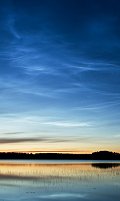
|
Erkki Rauhala,
Finland, Uurainen
Jul. 25, 2008 |
#1 |
Photo
details: Canon
5D and 17-35 mm/2,8 L. Focal lenght 30 mm. 100 ASA,
2 seconds, F/4. |
|
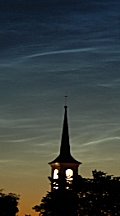
|
Kaie Josing,
Tallinn, Estonia
Jul. 25, 2008 |
#1,
#2, #3,
#4 |
I was on duty
in the hospital and walking in the corridor I suddenly saw
noctilucent clouds through the corridor window.I`ve followed
Spaceweather.com NLC gallery for some years, so I wanted
to see NLC myself.This year it was the second time and the
show was wonderful. The church is not like Pisa Tower, I
just took pictures through the window:))
Photo
details: Nikon
D80, Time:01:50-02:40 Exp.time 3-4 sec, F4-5,6, ISO
100 |
|

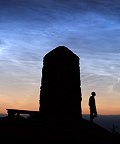
|
P-M Hedén,
South-Koster Sweden
Jul. 23, 2008 |
#1,
more |
In July the NLC displays has been fantastic here in Sweden.
Here comes a shot from the beautiful island of South-Koster Sweden. The panorama photo (four photos) is taken at the highest point on the island, a small mountain called Valfjäll.
There me and my friend had a great sight of Noctilucent clouds, it was a night to remember.
Photo taken with a Canon 450D and a 20mm Sigma.
|
|
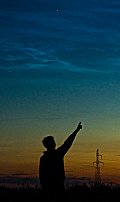
|
Marek
Nikodem,
Szubin, Poland
Jul. 21, 2008 |
#1,
#2, #3,
#4, more |
Noctilucent
clouds show continue ! Last night I observed great complex
NLCs. It was first clear sky after two cloudy weeks. I haven't
seen NLc so hight yet. The display was over 150 degrees
wide, over 100 degrees high. Even surpassing the zenith,
which must be quite rare for my latitude (53 N). I was shocked
- they very bright and very high in the sky. This NLCs season
is very long in Poland. Stunning!
Photo
details: Nikon
D50, exp.5-8 sec, iso 200-400 |
|

|
Mikhail
Yanchenko,
Ekaterinburg, Russia
Jul. 20, 2008 |
#1 |
Photo
details: Nikon
D80, 400 ASA, 3s exposure |
|
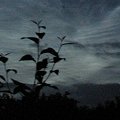
|
Michelle
Cosper,
Girdwood, Southcentral Alaska, USA
Jul. 20, 2008 |
#1,
#2,
#3,
#4,
more |
I
have been hoping to see some noctilucent clouds for months,
but the weather has been too overcast. When I got up at
2:20 am this morning, I got my first glimpse. There they
were at the head of the valley. I opened a window and snapped
off a few shots with my Canon Powershot before I went back
to bed. |
|
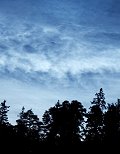
|
Mika
Yrjölä,
Espoo, Finland
Jul. 17, 2008 |
#1 |
First
set of noctilucent clouds I've seen during this summer already
better than any NLC show I saw last year.
Photo
details: Canon
EOS 20D and a 10-22mm lens, ISO 200, f/7.1, 3s exposure,
19mm focal length. |
more
images (July 25): from
Jukka Hölttä of Orimattila city, Village of heinämaa, Finland;
from
Aigar Truhin of Sigulda, Latvia; from
Kaie Josing of Tallinn, Estonia; from
Tom Eklund of Valkeakoski, Finland
more
images (July 24): from
Markku Nissinen of Kangaslampi, Finland
more
images (July 21): from
Ing. Peter Biely of Rajecka Lesna, Slovakia, Europe; from
Barbara Grudzinska of Warsaw, Poland; from
Aleksander Trebacz of Niepolomice, Poland; from
Matěj Grék of Ostrava, Czech republic, Europe
more
images (July 17): from
Mika Yrjölä of Espoo, Finland
|
|








